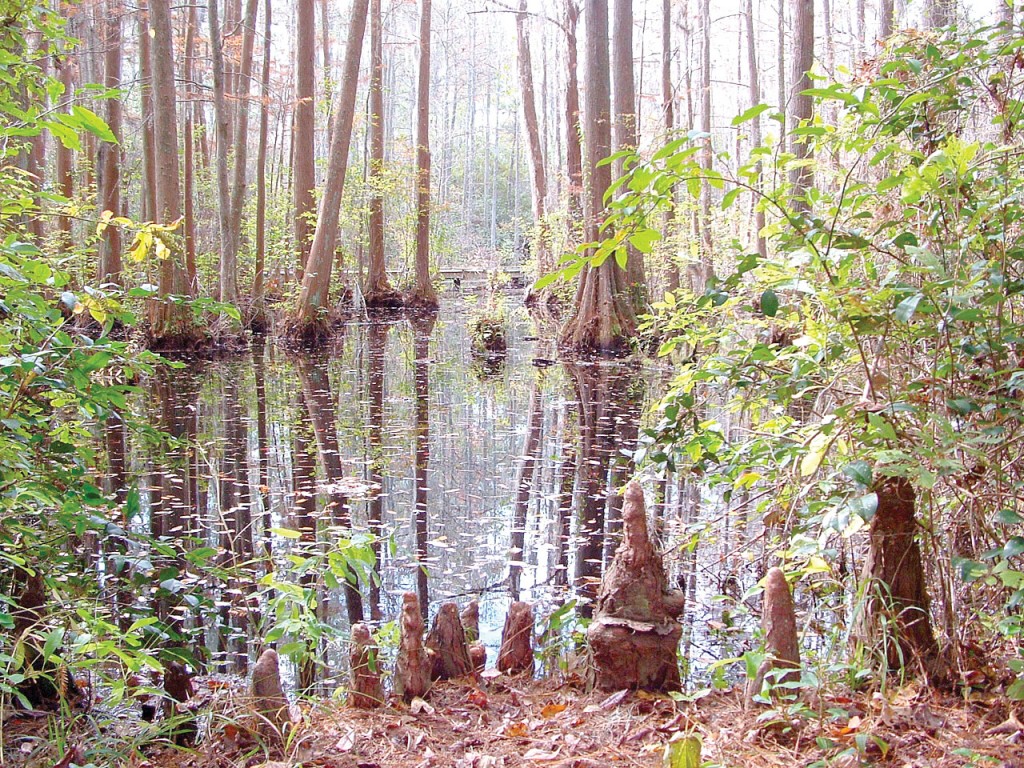Drive 87 miles southwest to the little town of Olanta and you’ll see a landform some folks believe meteors created — Woods Bay. It’s not the only bay, though. Thousands of Carolina Bays stipple the landscape from New Jersey to Florida (Aerial laser technology confirms a million.) The most beautiful fleck North Carolina, South Carolina and Georgia. A bit like divots, most bays occur in the Carolinas, hence “Carolina” Bays. We’re lucky to have a state park that preserves Woods Bay, a great example of a large bay yet to be destroyed by man. Yes, a drive of about 110 minutes will take you to this fascinating place, rich with wildlife and botanical wonders.
We call places like Woods Bay “bays” because bay trees — magnolias and laurels — dominate many of these pockets. At ground level they look like, well, like swamps. Chances are you’ve driven by many a Carolina bay and didn’t realize it. From the air, however, they are elliptical depressions oriented from northwest to southeast and parallel to each other.
Recently I went back to Woods Bay. It’s so remote and isolated you’ll hear no evidence of man save a jet now and then from Shaw Air Force Base. If you stand still and listen you’ll hear what sounds like rain. Organic rain! Acorns, leaves and twigs fall continually.
I was glad to see Woods Bay hasn’t changed much; a good thing. Years ago I helped make a film that explored the bays’ origins and extolled them as wildlife oases. I often shot footage at Woods Bay. Serene and isolated. Those words still describe Woods Bay. No, three words — all with equal weight — serene, isolated and primeval. Once upon a time I captured ancient creatures on 16-millimeter film. An anhinga drying its wings. A gator gliding past water lilies. A stubby cottonmouth braiding through cypress knees. Turtles sunbathing on logs. Primeval denizens. I felt like I was in 1800s Botswana.
There was a boardwalk, too, from which I filmed birds. (Woods Bay always delivered a profusion of wildlife … osprey, carnivorous plants, wood ducks and otter.) Today a new and far superior boardwalk will take you past sunning snakes and turtles and all types of luxuriant plant life. It’s a great place to hone your wildlife photography skills.
Coming back may years later, my film days behind me, I still find Woods Bay to be as delightful as ever. As November’s autumn light lit up orange cypress needles their images danced across black waters. I too reflected. Woods Bay and its fellow bays are quietly doing what they’ve always done: controlling floods, purifying water, stockpiling carbon and giving man a place to sort out things. Add clean air, sediment retention and nutrient recycling to the benefits. And add two things that banish humdrum: beauty and mystery, especially mystery.
The origin of Woods Bay and other bays most likely is long-term wind and wave action that gradually shaped the bays and piled sand at their southeastern ends. Don’t let that rather bland theory keep you from seeing a miraculous place. Pack a picnic. You’ll find a picnic shelter there and don’t miss the adjacent millpond. It’s rich with wildlife and photo opps too! And when you drive in you can’t help but notice the snowy-white sand rim that is a beautiful hallmark of Carolina bays.
If You Go …
• 11020 Woods Bay Road
Olanta, S.C. 29114
• 843-659-4445
• Free Admission, 9 a.m. to 6 p.m.
• Open daily from 8 a.m. to sunset
•www.southcarolinaparks.com/woodsbay/introduction.aspx
Learn more about Tom Poland, a Southern writer, and his work at www.tompoland.net. Email day-trip ideas to him at [email protected].








